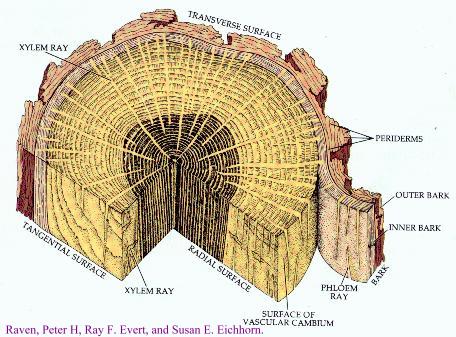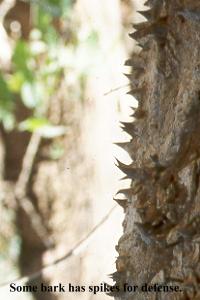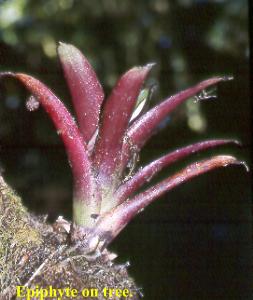Now the bark has two layers, the inner bark and the outer bark (see photo 1).

| MadSci Network: Botany |
Yes, this was a good observation, many of the trees that you see do have rough bark. You inquire if this is "for protection" or a "result of how the tree grows". Actually the answer is a combination of both. You first must understand how a tree grows.
Plants primarily exhibit two types of growth; primary growth and secondary growth. Primary growth results in the plant elongating (ie: growing longer). This growth occurs in the apical meristems of the shoot and root. In trees, the cells are laid down at the "ends" of the plant causing the roots or the shoot to grow longer. We know this due to the fact that, if you pounded a nail into a tree 4ft up and came back 10 years later the nail would still be 4ft from the ground, because a tree grows longer from its ends (the apical meristems).
However, some plants such as trees become "woody", this is due to
secondary growth. Secondary growth causes the tree to grow wider. This
growth comes from secondary or lateral meristems, the cork and the
vascular cambiums. Cells are produced here and push the existing cells
outward, causing the tree to have more girth. All of the tissues outside
the vascular cambium are collectively called the "bark".
Now the bark has two layers, the inner bark and the outer bark (see photo
1). 
The outer bark is the outermost part of the tree that you see. The cells of the outermost bark are dead and become hardened. Now you remember that the vascular cambium keeps producing new cells and this keeps pushing cells outward causing the tree to grow wider and wider. This can put a lot of stress (pressure) on these outermost cells causing them to break. As the tree continues to grow the pressure from growth (breaking and tearing) and the environment (rain, wind etc.) cause the bark to become rough.
Now we know that the way a tree grows can result in the bark being rough,
but remember I said that the protection of the tree also plays a part in
the bark characteristics. The bark is used in many ways to protect the
tree. The hard bark helps keep water from evaporating from the tree,
keeps some animals and insects from eating the tree, protects the inner
"alive" tissues from damage, and protects from fungi and diseases. These
are just a few examples there are many more (see photo 2)!

However, not all bark is rough. Some bark is smooth and this is for the
protection of the tree also. Many of the trees containing smooth bark can
bee seen in the tropical rain forests. The bark is smooth to keep any
epiphytes, plants that live on other plants, from growing on them (see
photo 3).

Too many epiphytes may suffocate the tree. Bark will also flake off to protect itself from epiphytes. This happens with both smooth and rough bark. Flaking bark is observed more in the tropics because there are so many epiphytes. In the temperate zones there are some clinging vines that are epiphytic, however lichens (a fungus and alga that live together as one organism) are the most prevalent type of epiphyte in the temperate forests. Many lichens love to live on the bark of trees. To protect itself the tree's bark will flake off, thus "throwing" the lichens and other epiphytes to the ground. As you can see, the bark of trees can be both rough and smooth. These bark characteristics are due both to the growth of the tree and the environmental conditions the tree encounters. The bark is used in many ways to protect the tree, flaking bark is just one example of the ways that bark can be used for protection.
Bark links:
http://www.caf.wvu.edu/bar
k/treelinks.htm
http://www.fw.vt.edu/
dendro/Forsite/idbark.htm
http://www.ent.iastate.edu/ipm/hortnews/1996/8-9-1996/shedbark.html
http://www.
fhsu.edu/biology/thomasson/BARK/Treebark.html
Lichen link:
http://www.lichen.com/
References
Bold, Harold C., and John W. La Claire II. The Plant Kingdom. Prentice- Hall Inc., New Jersey, 1961.
Kricher, John C., and Gordon Morrison. Ecology of Eastern Forests. Houghton Mifflin, New York, 1988.
Raven, Peter H, Ray F. Evert, and Susan E. Eichhorn. Biology of Plants. Worth Publishers, New York, 1992.
Try the links in the MadSci Library for more information on Botany.